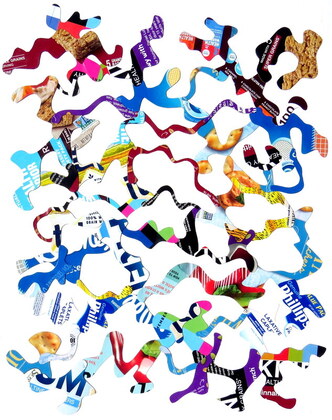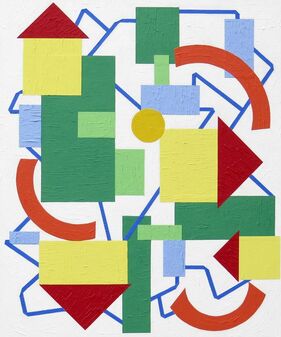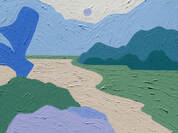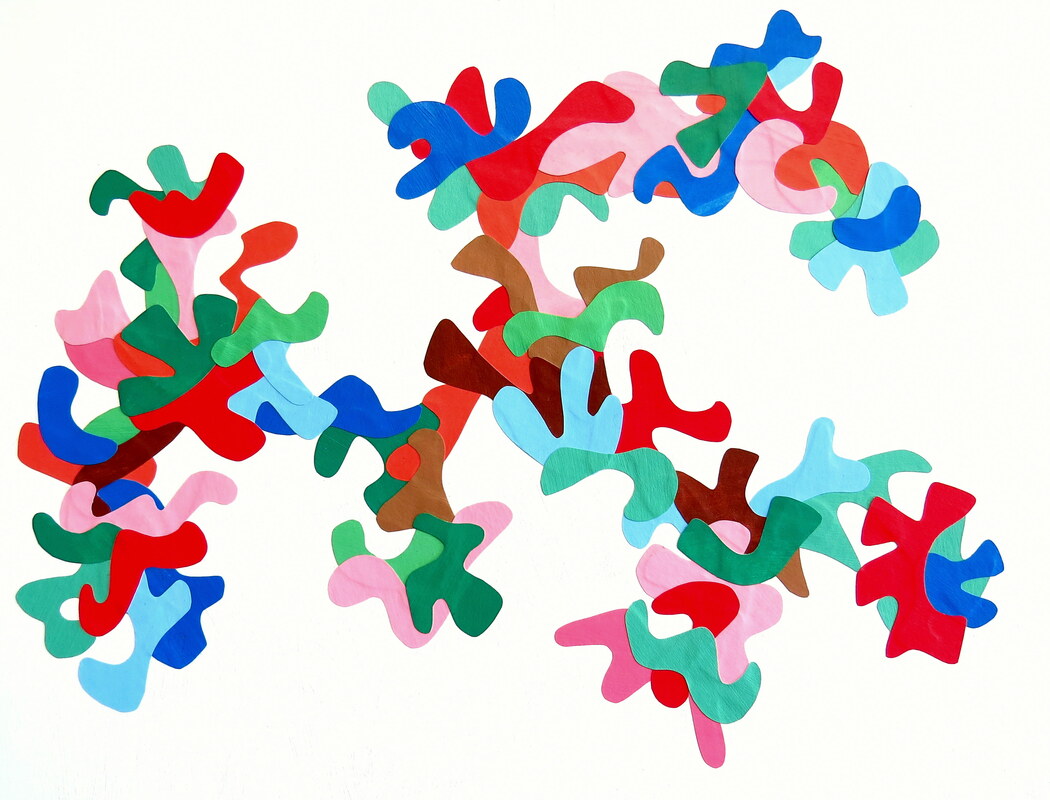|
In The End 16" x 20" Collage on Matboard Reclaimed packaging and magazine pages The above piece was completed yesterday. July has been a tough month for me. It took me a while to start something. Not because anything bad happened but because my anxiety and depression have gotten the better of me. Consumed by inertia, I really haven't been doing too much in the way of artwork, or anything else for that matter. But! This new collage has revived me somewhat. Sort of like one of those sponge animals that get soaked in water so they can expand. Does anyone remember those?
I had the idea for a while to try and use some of the leftover packaging materials from the food items that we buy. Every time I toss some cardboard packaging in the recycling bin I kind of wonder about it. Could it be used somehow by me in my art making? (I wonder too about the enormity of the waste that we make as a society, don't get me wrong. I am just saying that I also thought about making something out of this waste.) I scavenged some packaging and started to experiment a bit with it. There is some criteria for what I can use. The material needs to be varnished (this allows me to wipe the glue off of the finished shape with a damp cloth. The varnish resists the water). I also need to be able to cut the material easily, making cleanish lines. So, the packaging can't be too thick or more than my hands can handle. Lastly, the issue of matching the material to the substrate is important. If the cardboard is too heavy will it not adhere to the matboard? Will the shapes and the board and the glue all flex together once the board is ready for handling and framing? (Remember that these shapes are adhered to matboard which is about 1/8" thickness. I don't want them popping off if I handle the board and bend it a bit.) So far, so good. Everything seems to have passed my initial tests. Working with letters and writing and graphics was interesting. It was a challenge to try and get words and writing going in a direction that I thought would work. Those things do create a direction much like a line does. Values were a challenge to work with as well. I used the mono function on my camera a lot. I drew on the other guidelines that I normally use with my work: hue relationship, chroma, and value. I also added a few new "rules" to my repertoire. These shapes create a kind of "density" when they get grouped together. Think about a pile of laundry versus a pair of socks. Same thing. So in addition to the other things I look at I also started to examine this newish idea. For me, it really has to do with proportion and use of space. Everyone has their own tolerance for this. (I have seen artists who shove a bunch of elements into one corner of the canvas and try to get the remaining background color to sort of counter balance that mass. I always wonder about this.) I came to the conclusion while working that it's important to develop your own "rules." These should be guidelines that make sense to you and that you think up on your own through working and experience. Whether or not anyone else agrees or gets it, is kind of irrelevant. As long as you can draw on the logic and talk about it out loud, then I think you are on the right track. Anyway. Let me know what you think about any of this. Thanks again for reading and looking. My work is available on my site now. I have a new "shopping cart" function and secure checkout using PayPal. It can all be found right here. I also added a page about how to buy. If all else fails, send me an email! Thanks, Libby
0 Comments
Making Connections 2015 16" x 20" painted paper collage on board Recently, I began going back through my old posts on my previous blog, Quilted Craftsman/Libby Fife Fine Art Studio Blog. I was looking for posts in which I wrote about my ever evolving process of art making, how I learned about using my materials, personal insights, and any information on classes that I taught. I wrote a lot about all of these things and then some! All of the reviewing made me realize that writing about my art has helped me to understand how I got to where I am right now. I can see the progression of my skills, what and who influenced my style over the years, and most importantly, how I arrived at my current style. If I hadn't written about any of it, I may be hard pressed to remember the details! My review of old blog posts included reading about the making of the above piece. It's a good example of transitioning from directly painting landscapes on canvas using big shapes. An example of that style is shown in the image below, made in 2015. It is as good a comparison as any showing how I got from one place to another to arrive eventually at my current style today. It's easy to see that I was already in love with hard edged solid shapes; big representative forms, and color relationships. Conceptually, it wasn't much of a leap from this piece to the one shown above at the beginning of the post. The real leap came in the use of materials. I made the Connections piece with paper that I had painted and then affixed to the board with rice glue. It was one of the first times I had used painted paper shapes rather than painting directly onto the board. I remember (and wrote about this too) that I had been looking at Matisse's work (his cutouts), that I had been very frustrated with having to use tape to paint "clean" shapes like I wanted (hard edged images) and that honestly, I couldn't stand to paint one more landscape! (I love other people's landscape paintings, just not mine!) I really wanted to use different shapes, make different marks, and use personally representative imagery. I wanted the work to be more about what I was thinking and not just me looking at a pretty view.
In any case, I finished that above piece and was very happy with it. (I still am too.) It uses all of the design principles that I love so much: proportion, direction, variation, and repetition. The colors are crisp against that white background which is something I really enjoy visually. My work went on in this way through 2016. I switched to some other ideas for 2017 and 2018 but came back to this one in 2019. I never gave up using painted paper, however. That has been a constant and I know it's unlikely I will ever go back to painting directly. My point, and I am sorry it took me awhile to reach it, is that writing about (and reviewing that writing) is a worthwhile exercise. I suppose that people can just remember in their heads what happened but I am not one of those people. I have kept a sketchbook for the entire time I have been making art which is over 10 years now. (I came to this creative thing late in life!) I have also been blogging for that same time too. Both practices have been invaluable. They may both be out of date at this point but I don't care. I think the very act of writing itself is the key. Writing connects you to something inside yourself in a way that almost nothing else does. Yes, personal reflection and talking with others is important. Taking in outside information and being interested in the world around you is important. Those things are in fact necessary precursors to writing. But isn't it egotistical to focus so much on yourself, your art, and your processes? Maybe but how else can you know about you? I have run into more artists who can't articulate what their art is about or why they make art or even what they see in other people's art. This is a shame, really. My opinion is that writing would fix this problem! So? Go forth and write! Grab a pencil and notebook. Get a fancy sketchbook and beautiful pen. Go to your computer/phone/I Pad or whatever. Look inward and get going before it's too late! Thanks for reading. email: [email protected] Essential 11" x 14" painted paper collage on matboard This piece was meant to be a companion piece to this one shown here. I started to work both of them at the same time which is something I don't normally do. When I start to do something that is out of the norm for me, I often have to stop and ask myself why it is that I am deviating from my routine. It's important to be honest about things. Maybe I am genuinely interested in another approach to working on these pieces. I search inward to see if this feels right. If things don't feel kosher, then I look a little more. More often than not I uncover a hidden motive. This time I realized that I was working two pieces at once because I saw someone else do this; someone who is a professional painter with more experience than me. I also felt a little pressure to produce more work. God knows why but it's true. So, I stopped. I covered up the other piece and just worked on one piece at a time. That felt more like me.
There are reasons (and benefits) to work two or more pieces at once. I think the thought process has to do with efficiency and cohesiveness. Perhaps if you are an artist who needs to generate work for a show or gallery this practice could make sense, time wise. It could be that if you have multiple pieces in process in front of you, making marks on them at the same time, then they are bound to come out together as a related group. You might be trying out one idea in multiple ways or maybe are experimenting with a few materials to see what they can do over a broad swath of applications. Whatever the case may be, I am certain there are benefits to having several pieces going at one time. For me though, I am not a multi tasker anymore. I can do one thing at a time and that is it. Working on one collage, finishing the idea, and then moving on to the next thing is the way I work best. Yes, I get ideas for other pieces as I am working so I write those down for later. That is what my sketchbook is for (it's a journal as much as a sketchbook). Or maybe I have a question that needs investigating (I ask a lot of "what if?" type questions as I work) or I learn something about new materials to try. I write all that down and deal with it at a later time. Really, it's just one thing at a time and that's that. It makes me a slow producer but that will have to be OK. I often write these posts with three types of people in mind: myself of course, interested laypeople/other creatives, and beginning artists. I mention beginning artists but I don't mean those with a fresh BA degree. I really mean people that have been at their art for awhile and who are getting back into it. Or maybe just those of us who work on their art steadily but have questions. I honestly mean for my reflections to be useful. So, if you are reading and you can think of someone who would benefit from the discussion, please tell them and give them the link to my blog. I am trying to get my writing (as well as my work) out there in order to connect with others. Thanks for reading, Libby email: [email protected] work for sale |
Archives
July 2024
|





